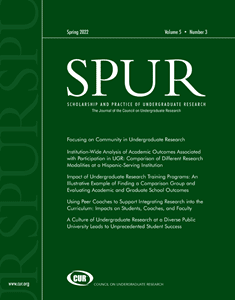SPUR (2022) 5 (3): https://doi.org/10.18833/spur/5/3/8
In this study, researchers at a large, urban, comprehensive minority-serving institution used propensity score matching to identify a unique comparison group to study academic and graduate school outcomes in students served by the National Institutes of Health–funded Building Infrastructure Leading to Diversity (BUILD) Initiative. Acknowledging that students’ self-selection biases may confound findings, the use of propensity methods to match students served with those who were not (but were otherwise eligible) provides a valuable tool for evaluators and practitioners to combat this challenge and better evaluate their effectiveness and impact on students’ success. This study’s findings indicate that BUILD participants had higher academic and graduate school success with regard to cumulative GPA, units attempted and completed, graduation status, and application and admission to graduate programs.
More Articles in this Issue
- Vignette‐ Ambria C. Crusan and Megan Baumler
SPUR (2022) 5 (3): https://doi.org/10.18833/spur/5/3/4 - Vignette‐ Christopher D. Foley and Elizabeth Englebretson
SPUR (2022) 5 (3): https://doi.org/10.18833/spur/5/3/2 - Vignette‐ Kristine Lamm West and Caroline Krafft
SPUR (2022) 5 (3): https://doi.org/10.18833/spur/5/3/1 - Practice‐ Linda J. Walters, Kimberly R. Schneider, and Mary L. Tripp
SPUR (2022) 5 (3): https://doi.org/10.18833/spur/5/3/5 Abstract:Undergraduate retention, graduation, and postgraduation success are greater when students engage in undergraduate research. This article describes a grassroots, facultyinitiated effort to increase the number of students who received research experiences at a large, urban institution. Peer course coaches, students who had previously taken a course or with specific skills, helped faculty from all disciplines embed research in their undergraduate curriculum. The effectiveness of this program model for students (e.g., enhanced learning, new skills), coaches (e.g., leadership development), and faculty (overall experience) was evaluated. Data suggested program success from all participants. Everyone benefited from this model: faculty maximized student engagement, coaches received leadership experience, and undergraduates had experiences that will positively impact their lives and livelihoods.
- Article‐ Claudia Knezek, Patricia Morreale, Susan Gannon, George Chang, and Jeffrey H. Toney
SPUR (2022) 5 (3): https://doi.org/10.18833/spur/5/3/6 Abstract:Student participation in science, technology, engineering, and mathematics (STEM) undergraduate research experiences has received national emphasis. The undergraduate research model used at a comprehensive public university supported faculty-mentored student projects across STEM and all disciplines. Between 2016 and 2019, 356 undergraduate students presented their research work annually at a campus showcase, with participation levels more than doubling over time. A rigorous study identified best practices for engaging all undergraduate majors in authentic research experiences. Results confirmed that the undergraduate research model successfully supported both traditional and minority populations. At the same time, 24 percent more STEM-related majors maintained an overall 0.13 higher first-year GPA than the general population of undergraduates. In addition, campus engagement was 42 percent higher for the showcase participants.
- Assessment‐ Samantha Jude Battaglia, Lourdes E. Echegoyen, Laura A. Diaz-Martinez
SPUR (2022) 5 (3): https://doi.org/10.18833/spur/5/3/9 Abstract:Most studies on the benefits of participation in undergraduate research (UGR) use data from student participants in undergraduate research programs (URPs), which offer a limited number of positions. In reality, however, the majority of UGR students participate in undergraduate research not in programs (URNPs). The authors conducted an institution-wide study at a Hispanic serving institution to examine the relationship between academic success and participation in these two UGR modalities. Although there were some differences between URPs and URNPs, participation in research at this institution was largely equitable and inclusive, with UGR demographics that reflected those of the institution, and it was positively associated with increased benefits along multiple academic metrics, regardless of UGR modality. Importantly, these increases were observed for both first time in college and transfer students.


